Maintaining a clean and well-placed feeder is essential for attracting birds and keeping them healthy. Proper placement can prevent seed from falling to the ground, which often attracts unwanted visitors like squirrels. A messy feeder not only wastes seed but can also lead to health issues for birds1.
Regular cleaning is crucial to avoid mold and disease. Feeders should be cleaned every two weeks, or more often during wet weather or if sick birds are observed. A mixture of one part bleach to nine parts water is recommended for effective cleaning2.
Choosing the right seed can also minimize mess. Hulled sunflower seeds, for example, leave less debris compared to unhulled seeds. This ensures a cleaner feeding area and reduces waste3.
By following these simple steps, you can create a welcoming and safe environment for birds. This not only benefits the birds but also enhances your enjoyment of watching them in your yard.
Table of Contents
Key Takeaways
- Proper feeder placement prevents seed spillage and deters squirrels.
- Regular cleaning avoids mold and disease spread among birds.
- Use hulled sunflower seeds to reduce mess and waste.
- Clean feeders every two weeks or more often in wet weather.
- Create a safe and inviting space for birds in your yard.
Understanding the Challenges of Messy Bird Feeders
Seed spillage around feeders often leads to unintended consequences. When seeds accumulate on the ground, they attract not only birds but also squirrels and other unwanted visitors. This can disrupt the feeding area and create a messy environment4.
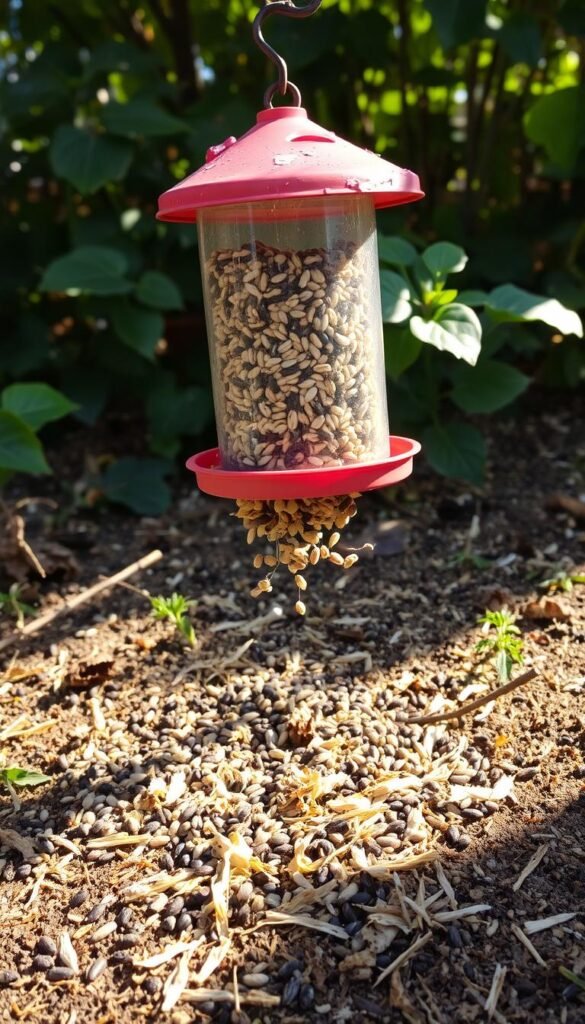
Identifying the Sources of Mess and Seed Spillage
One of the main challenges is improper feeder placement. If a feeder is too low or unstable, seeds can easily fall to the ground. Overcrowding at the feeding station also contributes to spillage, as birds compete for food5.
Certain types of seeds, like unhulled sunflower seeds, leave more debris. This not only wastes food but also creates a messy feeding area. Regularly checking and adjusting the feeder can help minimize these issues.
The SWISSINNO bird feeder is my personal pick to help eliminate the typical bird feeder messes.
- 🐀 SECURE BIRD FEEDER DESIGN: Smart and protective design with controlled access keeps seed secure for birds only – desig…
- 🛡️ WEATHER-RESISTANCE & BUILT TO LAST: Made with UV-resistant ASA plastic, a durable polycarbonate seed container, and s…
- ♻️EFFICIENT FEEDING WITH INTEGRATED CATCH TRAY: The clever catch tray design reduces spillage by up to 50%, saving seed …
- 🌿 DUAL-CHAMBER SILO FOR MIXED BIRDSEED: Features two separate seed chambers to offer multiple food types at once – ideal…
- 🏡 VERSATILE HANGING BIRD FEEDER: Easy to hang in the garden, on balconies, or patios. A year-round feeding station that …
Health and Safety Concerns for Birds
Spilled seeds can lead to serious health risks for birds. Mold and bacteria thrive in damp conditions, especially when seeds are left on the ground. Diseases like salmonellosis and trichomoniasis can spread quickly among birds feeding in contaminated areas5.
Infected birds often continue to feed until they become emaciated, increasing the risk of disease transmission. Cleaning the feeder and the surrounding area regularly is essential to prevent these health hazards4.
Understanding these challenges is the first step toward creating a safer and cleaner environment for birds. By addressing spillage and maintaining hygiene, you can protect the health of your feathered visitors.
How to Solve Messy Bird Feeders with Simple Tips
Effective feeder placement can significantly reduce seed spillage. Proper positioning ensures a cleaner feeding area and minimizes waste. It also helps keep unwanted visitors like squirrels at bay6.
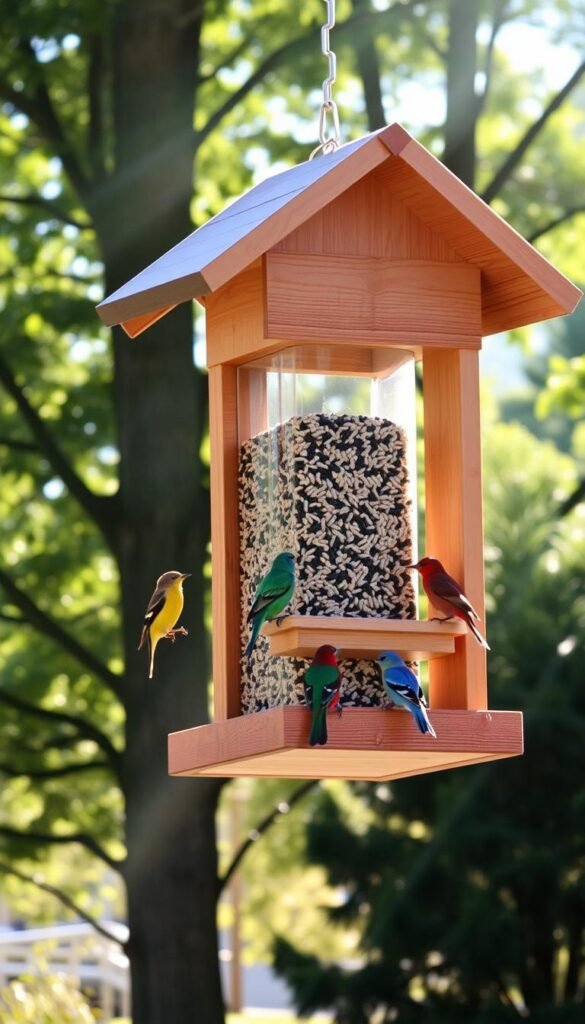
Selecting the Ideal Feeder Placement for Cleanliness
Positioning your feeder at least 10 feet away from trees and fences deters squirrels6. A height of 5 feet off the ground prevents access by larger animals like raccoons7. Placing feeders near windows allows for easy observation and timely maintenance.
Feeders with weight-activated perches should have 18 inches of clearance on all sides to prevent squirrel access6. This ensures only birds can feed, reducing seed loss and mess.
Effective Strategies to Minimize Seed and Debris on the Ground
Using tray feeders or those with sides can reduce spillage7. Hulled sunflower seeds leave less debris compared to unhulled varieties. Regularly collecting fallen seed prevents buildup and keeps the area clean.
Fresh seed is crucial. Wet or clumped seed can become moldy, harming birds6. Offering safflower seeds can deter bully birds like crows, ensuring a cleaner feeding station7.
Deterring Squirrels and Other Non-Target Visitors
Squirrel-proof feeders are four times more shake-resistant than standard models6. These feeders prevent access to squirrels, reducing seed loss. Adding ant guards above hummingbird feeders keeps pests away7.
Hanging feeders in shaded areas maintains nectar freshness, especially in high temperatures7. Using a plastic woodpecker decoy can also deter woodpeckers from pecking on houses7.
| Strategy | Benefit |
|---|---|
| Place feeders 10 feet from trees | Deters squirrels |
| Use tray feeders | Reduces seed spillage |
| Offer safflower seeds | Keeps bully birds away |
| Install squirrel-proof feeders | Prevents seed loss |
Essential Tools and Cleaning Supplies
Keeping your feeding station clean requires the right tools and techniques. Regular maintenance ensures a healthy environment for visiting birds and prevents the spread of disease8. With the proper supplies, cleaning becomes efficient and effective.
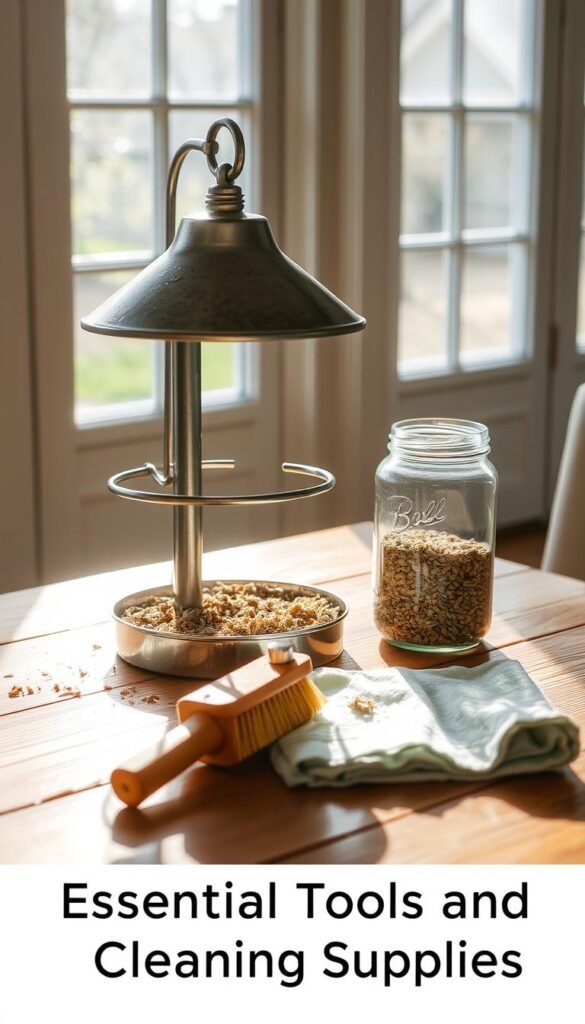
Must-Have Items from Gloves to Bleach
To clean feeders thoroughly, gather essential supplies. These include gloves, a tub, dish soap, scrub brushes, and a bleach solution. A mixture of one part bleach to nine parts water is recommended for sanitizing8.
Specialized tools like tube feeder brushes are ideal for cleaning hard-to-reach areas. For wooden feeders, avoid harsh chemicals that could damage the material. Instead, use warm, soapy water or a vinegar solution for gentle cleaning9.
Step-by-Step Guide to Thorough Feeder Cleaning
Start by emptying old food and debris from the feeder. Use a brush to remove stuck-on residue. Soak the feeder in a bleach solution for 10-15 minutes to kill bacteria and mold8.
Rinse the feeder thoroughly with clean water to remove any bleach residue. Allow it to air dry completely before refilling. This ensures no harmful chemicals remain in the feeding area9.
For tube feeders, use a specialized brush to clean the interior. Regular cleaning prevents disease spread and maintains the feeder’s appearance over time10.
During wet or winter weather, increase cleaning frequency to prevent mold growth. A clean feeder not only protects birds but also enhances your enjoyment of watching them in your yard.
Maintaining a Safe and Bird-Friendly Environment
Creating a safe environment for birds involves regular maintenance and thoughtful practices. A clean feeding area not only attracts more birds but also protects them from disease and other hazards. By following a few key steps, you can ensure your yard remains a welcoming space for these feathered visitors.
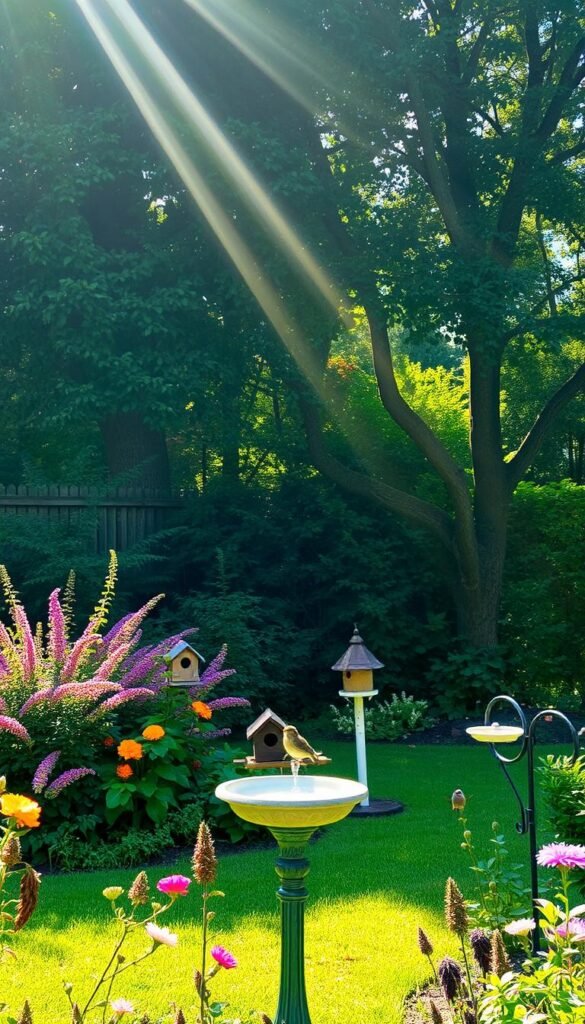
Preventing Disease, Mold, and Cross-Contamination
Regular cleaning is essential to prevent the spread of illness among birds. Feeders should be disinfected every two weeks using a solution of one part bleach to nine parts water11. During wet weather or if sick birds are observed, increase cleaning frequency to avoid mold growth12.
Remove fallen seed and debris from the ground to prevent attracting pests and fostering disease. Bright green droppings around feeders can indicate illness, so monitor birds for symptoms like lethargy or crusty eyes11. Proper hygiene reduces the risk of cross-contamination and keeps birds healthy.
Feeder-Specific Care: Wood, Copper, and Tube Feeders
Different feeder materials require unique care to maintain their functionality and appearance. Wooden feeders benefit from reapplication of linseed oil or wood sealer when weathered. This protects the material from moisture and extends its lifespan.
Copper feeders should be polished regularly to maintain their shine. Applying a clear lacquer can prevent tarnishing and keep them looking new. For tube feeders, use warm water and mild soap for cleaning. Avoid harsh chemicals that could damage the plastic material12.
| Feeder Type | Maintenance Tips |
|---|---|
| Wooden | Reapply linseed oil or sealer when weathered |
| Copper | Polish regularly and apply clear lacquer |
| Tube | Clean with warm water and mild soap |
By following these care practices, you can maintain a safe and inviting feeding area for birds. Regular upkeep not only benefits the birds but also enhances your enjoyment of watching them in your yard.
Integrating Best Practices for Year-Round Feeding
Adapting your feeding routine to seasonal changes ensures a healthier environment for birds. Weather patterns and temperature shifts directly impact how you manage your feeding station. By making small adjustments, you can provide consistent support while addressing seasonal challenges.
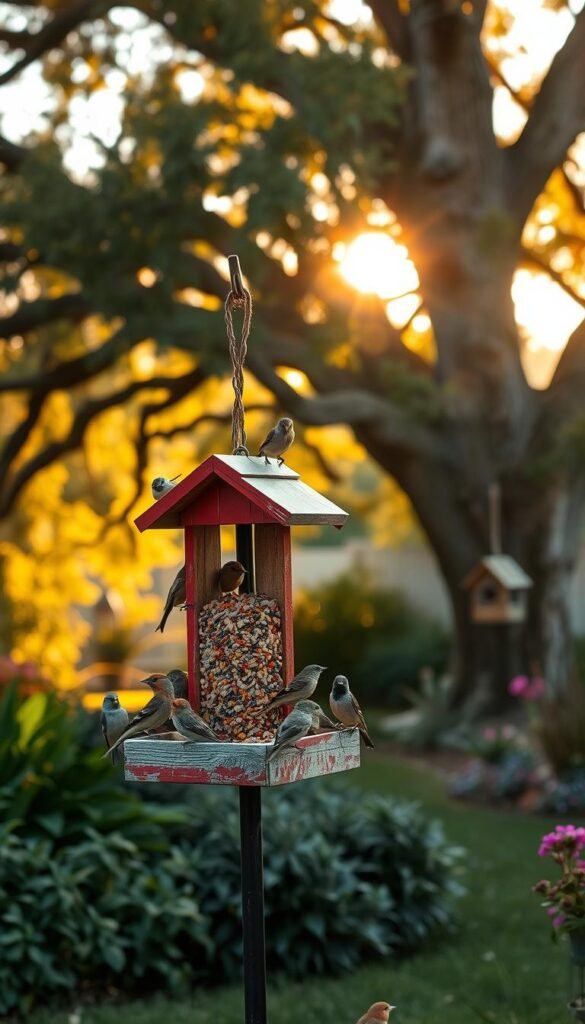
Adapting Your Routine to Seasonal Changes and Weather
During wet or winter weather, cleaning your feeder more frequently is essential. Mold and bacteria thrive in damp conditions, increasing the risk of disease13. A solution of one part bleach to ten parts water is effective for sanitizing13.
Adjusting feeder placement can also improve safety and maintenance. In winter, position feeders away from icy or snowy areas to prevent hazards. Placing them near windows allows for easy observation and timely cleaning14.
After harsh weather events, check your feeding station for debris or damage. Promptly clean any accumulated waste to maintain a healthy environment. This prevents pests and ensures birds have access to fresh food15.
Monitoring bird behavior during seasonal transitions is crucial. Signs of stress or illness, like lethargy or crusty eyes, may indicate a need to adjust feeding routines. Providing a steady supply of food during harsh conditions supports bird survival14.
Incorporating weather-resistant designs can protect your feeder from damage. Window collision prevention decals also reduce risks for birds feeding near glass surfaces. These small changes make a big difference in creating a safe feeding area15.
By balancing consistent feeding with seasonal adjustments, you can support birds year-round. Regular maintenance and thoughtful practices ensure a welcoming environment for your feathered visitors.
Conclusion
Ensuring a clean and well-maintained feeding area is key to supporting healthy bird populations. Spillage and debris can attract pests like squirrels and lead to health risks for birds. Regular cleaning with a bleach solution prevents mold and disease, keeping your feathered visitors safe16.
Strategic placement of feeders reduces mess and deters unwanted visitors. Position them at least 10 feet from trees and 5 feet off the ground to minimize access by larger animals17. Seasonal adjustments, like increasing cleaning frequency during wet weather, further protect birds from harm.
By adopting these practices, you create a welcoming environment that benefits both birds and your yard. Start today and enjoy the rewards of a cleaner, healthier feeding station. Share your success and continue learning to enhance your bird-friendly space.

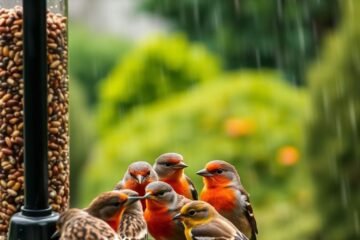
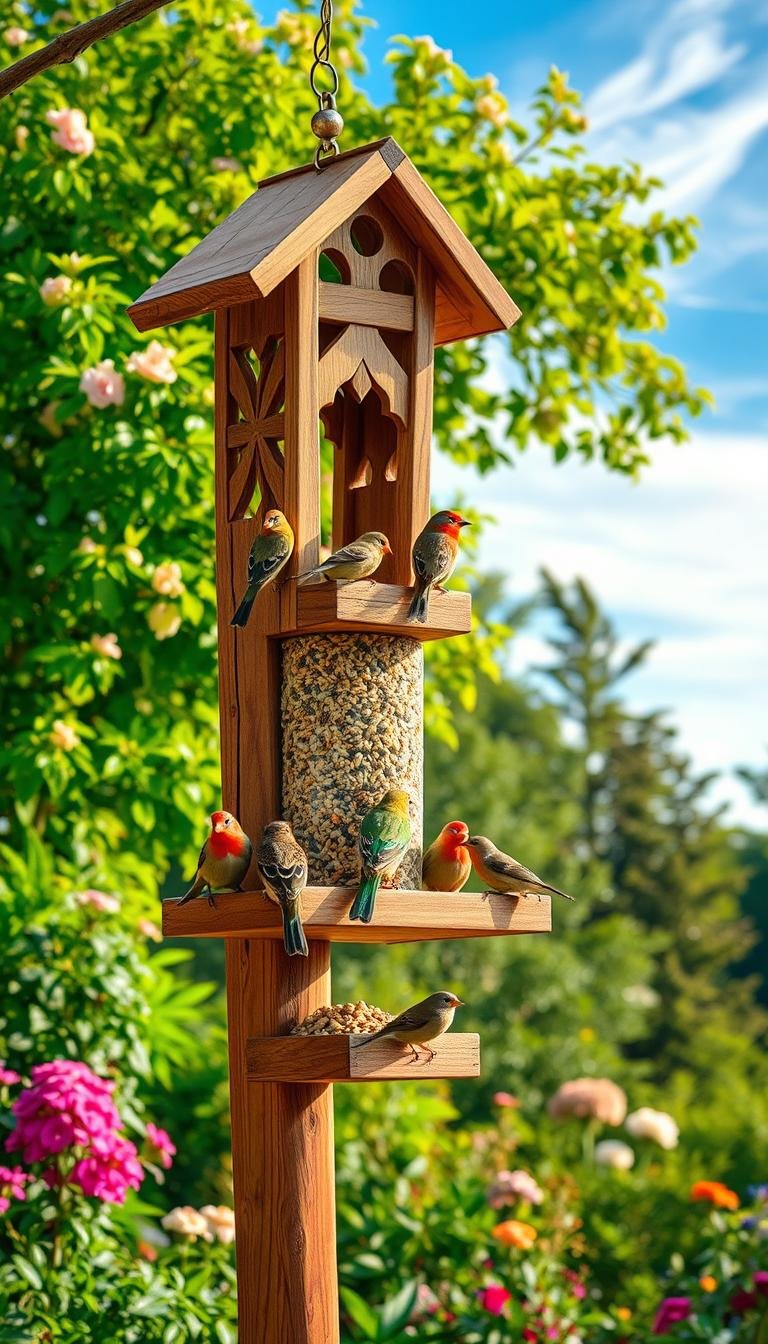

0 Comments